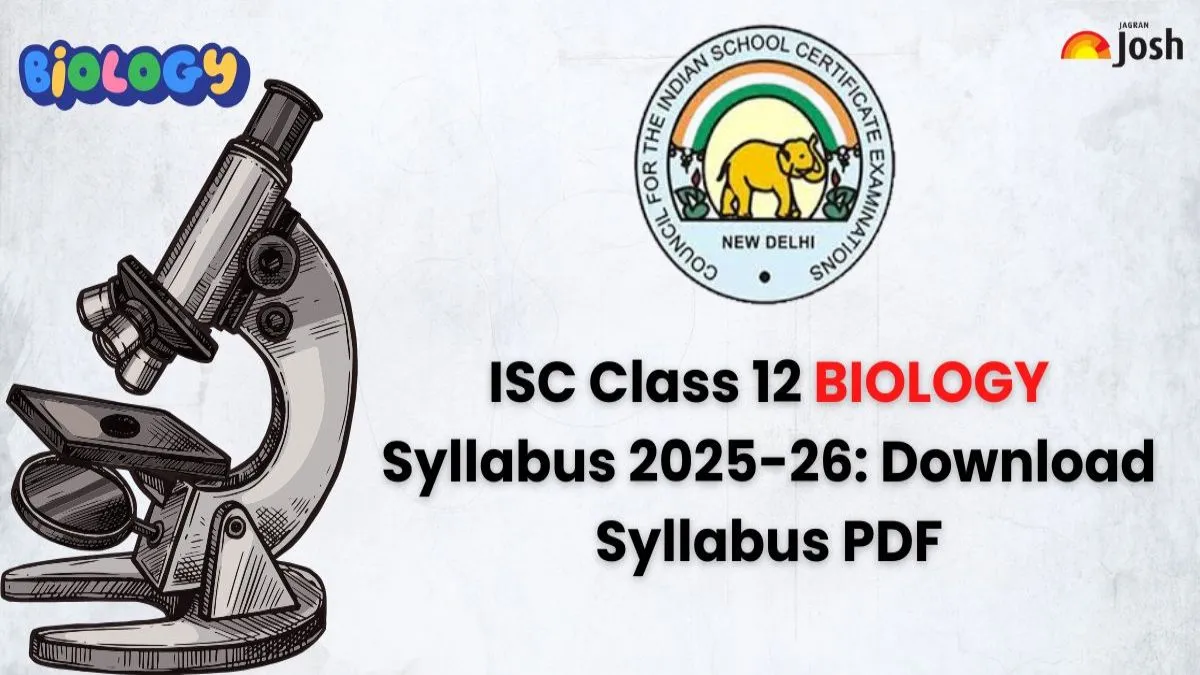ISC Class 12 Chemistry Syllabus 2025-26: As the new academic session is ongoing, many boards have released their revised syllabus for 2025-26. The ISC board is also one of them. It has made the syllabus available for classes 9th to 12th. If the students want to check the Class 12th Chemistry syllabus, they can refer to this article. As a part of the syllabus, students can get to know about the assessment types, evaluation scheme, topics and chapters to be covered, chapter-wise marks distribution, and more. The curriculum is prepared with the objective of ensuring the development of effective communication skills, providing students with vast practical experiences, thus promoting practical learning at the school level, and providing holistic education to students. Check the full syllabus here.
ISC Class 12 Biology Syllabus 2025-26: Detailed Course Structure
Find the ISC Class 12 Biology Syllabus 2025-26 in the table below:
| Reproduction (i) Sexual reproduction in flowering plants: Flower structure; development of male and female gametophytes; pollination - types, agencies, and examples; outbreeding devices; pollen-pistil interaction; double fertilisation; post-fertilization events - development of endosperm and embryo, development of seed and formation of fruit; special modes - apomixis, parthenocarpy, polyembryony; Significance of seed dispersal and fruit formation. (ii) Human Reproduction: Male and female reproductive systems; microscopic anatomy of testis and ovary; gametogenesis - spermatogenesis and oogenesis; menstrual cycle; fertilisation, embryo development up to blastocyst formation, implantation; pregnancy and placenta formation (elementary idea); parturition (elementary idea); lactation (elementary idea). (iii) Reproductive Health: Need for reproductive health and prevention of Sexually Transmitted Diseases (STDs); birth control - need and methods, contraception and medical termination of pregnancy (MTP); amniocentesis; infertility and assisted reproductive technologies |
| Genetics and Evolution (i) Principles of inheritance and variation: Heredity and variation: Mendelian inheritance; deviations from Mendelism - incomplete dominance, co-dominance, multiple alleles and inheritance of blood groups, pleiotropy; elementary idea of polygenic inheritance; chromosomal theory of inheritance; sex determination, linkage and crossing over; sex linked inheritance; Mendelian disorders in humans; chromosomal disorders in humans. (ii) Molecular basis of Inheritance: Chromosomes and genes; Search for genetic material; structure of DNA and RNA; DNA packaging: central dogma; DNA replication; transcription, genetic code, translation; gene expression and regulation - lac operon; human and rice genome projects; DNA fingerprinting. (iii) Evolution: Origin of life; biological evolution and evidence for biological evolution (palaeontology, comparative anatomy, embryology and molecular evidence); Darwin's contribution, modern synthetic theory of evolution; mechanism of evolution - variation (mutation and recombination) and natural selection with examples, types of natural selection; gene flow and genetic drift; Hardy - Weinberg's principle; adaptive radiation; human evolution. |
| Biology and Human Welfare (i) Human Health and Diseases: Pathogens; parasites causing human diseases (viruses, bacteria, protozoans, helminths, and fungi). Basic concepts of immunology - vaccines, cancer, HIV and AIDS; Adolescence - drug and alcohol abuse. (ii) Microbes in Human Welfare: In household food processing, industrial production, sewage treatment, energy generation and microbes as biocontrol agents and biofertilisers. Antibiotics |
| Biotechnology and Its Applications (i) Biotechnology - Principles and processes: Genetic Engineering (recombinant DNA technology). (ii) Biotechnology and its applications: Applications of biotechnology in health and agriculture: human insulin and vaccine production, stem cell technology, gene therapy; genetically modified organisms - Bt crops; transgenic animals; biosafety issues, biopiracy and biopatents. |
| Ecology and Environment (i) Organisms and Populations: Population, population interactions - mutualism, competition, predation, parasitism; population attributes - growth, birth rate and death rate, age distribution (ii) Ecosystem: Ecosystem patterns, components, productivity and decomposition; energy flow; pyramids of number, biomass, energy. (iii) Biodiversity and its Conservation: Concept of biodiversity; patterns of biodiversity; importance of biodiversity; loss of biodiversity; biodiversity conservation; hotspots, endangered organisms, extinction, Red Data Book, biosphere reserves, national parks, sanctuaries and Ramsar sites. |
Now that the syllabus is available, the students can check it and also get the direct link here.
Direct Link:
ISC Class 12 Biology Course Structure 2025
Here, students can find the ISC Class 12 Biology course structure for the academic session 2025-26
| S.No | UNIT | TOTAL WEIGHTAGE |
| 1 | Reproduction | 16 marks |
| 2 | Genetics and Evolution | 15 marks |
| 3 | Biology and Human Welfare | 14 marks |
| 4 | Biotechnology and Its Applications | 10 marks |
| 5 | Ecology and Environment | 15 marks |
| Total | 70 Marks | |
| Practical Work | 15 marks | |
| Project Work and Practical File | 15 marks | |
ISC Class 12 Biology Project Work Evaluation Criteria
Check the evaluation criteria for ISC Class 12 Biology in the table below:
| Assessment Type | Marks |
| Project Work
| 10 marks |
| Practical File
| 5 marks |
Also Check:
